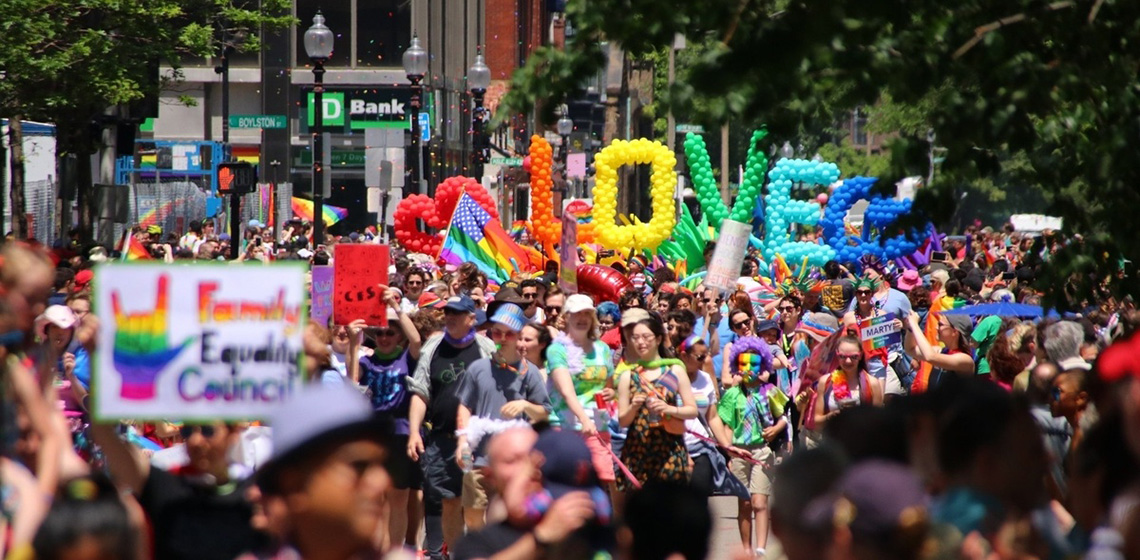’Rainbow Resistance’: that was the slogan of this year’s Boston Pride. You may ask what that means – what exactly are we resisting and what ’rainbow resistance’ is supposed to be – I asked myself the exact same questions. Despite residing in Boston for four years I’ve never been to the local Pride, so on June 9th I made my way downtown, excited to experience the Pride of an accepting American city. What awaited me there was at first beautiful and inspiring but raised more and more questions as the event proceeded.
Upon arrival I was met with a heart-warming scene: a crowd of people, extravagant clothes, creative hairstyles, sunshine, rainbow flags all over the place, a colourful flurry of laughter and jubilation, all in the heart of the city. Some of the notable buildings of the city also sported rainbow flags. The fences, familiar from Budapest, meant to separate the march from the spectators was also noticeably missing. Furthermore, while the police was present – this being America where cops are everything – the actual coordination of the march was done by the organisers of Pride (presumably volunteers).

It was hard to take in all of this, because it was just so different from what you get in Budapest. I waited eagerly for the march itself to start. In a short time and with no announcement, it started: this in and of itself was strange – what about the speeches? Who’s sending this march off?
A variety of companies headed the march: pharma, IT developers, insurance firms; many of them on foot, some on trucks. Their representatives – presumably LGBTQ+ employees – mostly wore uniform T-shirts made for the occasion and were handing out company merch to the spectators: bracelets, bags, bookmarks, necklaces. The majority were simply walking, hardly anyone was dancing and there was surprisingly little music.

As firm after firm passed – banks, insurance companies, Amazon-Goole-et. al. and a handful of non-profits like schools, libraries or animal shelters I kept asking myself when the turn for ordinary LGBTQ+ people to march will come. Even for the exceptionally brave it would have been hard to join in with the companies, because anyone would have stood out among all the uniforms like a sore thumb. So all there was left to do was to watch the companies as they passed. Another thing I noticed was that the rich companies like Amazon and various banks were marching at the front, the non-profits at the back. Does that mean that the bigger companies bought their prominent places?

As the time passed and the endless flow of representatives of clothing lines, brands, banks and insurance companies marched by, continuously handing out tons of bracelets and flasks (which the crowd accepted with unwavering enthusiasm), a question arose in me: who or what exactly we were celebrating here? How does me being gay get expressed by cheerfully greeting the representatives of Reebok, Converse, Google or the Bank of America as they march by? Did I come to Pride just to put my hands on a Macy’s bag or a Gap hat? What exactly should I be proud of?
Who was this Pride about? The LGBTQ+ people who, even with the rising levels of acceptance, still face a daily struggle at school or at work? Or rather about the companies who like to parade as the flagships of acceptance, but who know how they actually treat their LGBTQ+ employees? Or is this Pride solely about consumption: let us enjoy ourselves, collect a heap of mostly useless free trinkets and entertain the notion that maybe we should (no, we need to!) buy a Converse.

Make no mistake: let companies provide funding for Pride. They may even march at Pride. It’s important for the companies to make a statement about how acceptance of LGBTQ+ people is among their core values. The same goes for politicians: their presence at Pride signifies that they stand for a legal system that treats every human being equally. But if Pride is all about them and not us, something somewhere went very wrong.
The position of non-profits – schools, universities, libraries, homeless shelters – is obviously different. For one, they can’t support the message of Pride with funding, only by their presence. Besides, celebrating acceptance in a school environment (both among students and teachers) is completely different from trying to be proud of a bank or an insurance company. Schools are educating people, banks and pharma companies do not. Supporting the vulnerable, be they humans or animals, is the duty of the LGBTQ+ community too, because the community itself was shaped and is still characterised by the experience of vulnerability, of being an unaccepted outsider.

Will there ever be a place for LGBTQ+ people themselves at this Pride? Will there be a moment when you can march without uniform T-shirts and handout-merch, surrounded by the enthusiastic cheers of spectators? Will we get to the point where we’re celebrating ourselves, the LGBTQ+ community, an it’s this community that we’re proud of: diversity, love, and having survived despite everything thrown in our way?
As the last company passed by and the march came to an end, I already knew the answer.
Translated by Zsófia Ziaja

